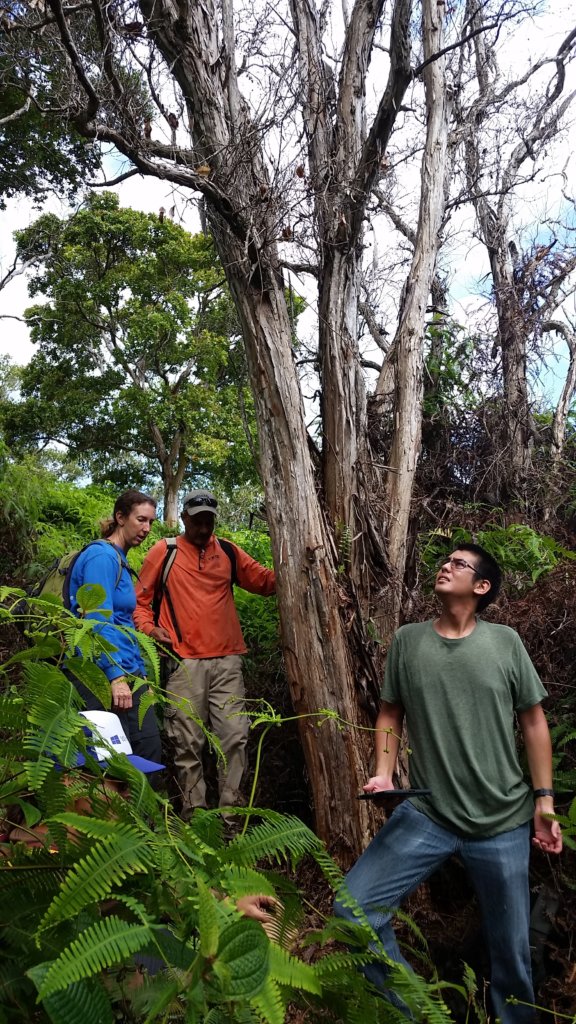Guest blog by Melissa Fisher, Director of Kauai Forest Program, The Hawai’i Chapter of The Nature Conservancy
One evening early in May 2018 I received a call from the Kauaʻi Department of Forestry and Wildlife (DOFAW) branch manager that started with, “Are you sitting down?” She quickly shared with me devastating information that the deadly disease that has killed thousands of trees on the island of Hawai’i, Rapid ʻŌhiʻa Death (ROD), had now also been found on the island of Kauaʻi. ʻŌhiʻa trees anchor Kauaʻi’s native forest and are deeply significant culturally. The thought that kept running through my mind was, “we thought we had more time.”
A state forester noticed a suspect tree on Forest Reserve land on Kauaʻi and sent a sample to the lab on Hawai‘i island. The sample tested positive for the less aggressive of the two fungal pathogens that are present on Hawai‘i island, named Ceratocystis huliohia. Though less aggressive, it is still a grave threat to ʻōhiʻa forests.
Over the last year, Kauaʻi conservation leaders have been meeting quarterly to review information about the spread of the fungus on Hawai‘i Island and discuss science, signage, and communications plans. We planned to raise public awareness on Kauaʻi, in the hopes of preventing the spread of ROD to our island and our ʻōhiʻa forests.

The phone call was quite a shock, but because we were already organized, we were able to mobilize quickly on Kauaʻi and collaborate with experts from Hawaii island to survey, sample more trees, and determine the best next steps.
There is a lot we do not yet know about the infected area but teams from multiple organizations are working together to determine its extent. A variety of techniques are being used, including: digital sketch mapping of trees using teams in a helicopter, drone surveys to assist with on-the-ground sampling , and testing of a new remote sensing digital mapping technique to map larger areas of the forest.
(photo: Forest survey crew with staff experts from Hawaii island helping to sample suspect trees. credit: L. Behnke, TNC)
All conservation teams on Kauaʻi are on alert in their work areas to report any ʻōhiʻa trees that might have been killed by the fungus. The ROD fungus itself is not visible on the outside of the tree, so a few characters may help determine if your tree might be infected. First, an apparently healthy tree’s crown will turn from green to yellow then brown and appear dead over a few days to weeks if it has ROD. Next, leaf death will not be scattered but entire branches or the entire crown will die at once. If the tree is in a location were ROD is rare or unconfirmed, then it is possible that the tree died from something other than ROD such as injury or other pathogens. There are several diseases that kill ʻōhiʻa trees and show symptoms similar to ROD. If the tree is in a location where ROD is already prevalent, then it’s very likely that the tree has died from ROD infection. To be positive that the tree has ROD, you would have to submit a sample for testing.
On Kauaʻi, we are asking everyone to help prevent the spread of ROD by doing these five things:
- Avoid injuring the bark, branches, or leaves of ʻōhiʻa trees.
- Don’t move ʻōhiʻa wood or ʻōhiʻa parts.
- Don’t transport ʻōhiʻa wood or parts inter-island.
- Clean gear and tools, including shoes and clothes, before and after entering forests. Brush all soil off of tools and gear, then spray with 70% rubbing alcohol. Wash clothes with hot water and soap.
- Wash the tires and undercarriage of your vehicle to remove all soil or mud when off-roading or have picked up mud from driving.
Our collaborative team is also laying the groundwork to reach out across Kaua’i to reach specific groups of people who can help spread the word and help prevent the spread, such as; large equipment operators, large land-owners, cultural practitioners, and all forest users.
For more information:
- Read our April 2017 blog post on ROD with more details on how the fungus spreads, Hope for Hawai’i’s Threated Keystone Tree, ʻŌhiʻa, by Corie Yanger.
- Find all the details on this pathogen on our Invasive Species Profile page for Rapid ʻŌhiʻa Death



